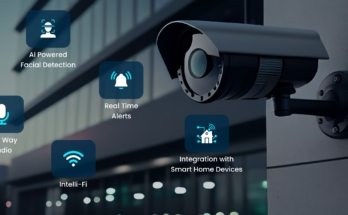Introduction
Imagine a futuristic factory where machines communicate, analyze, and make real-time decisions. This is no longer a fantasy it’s the reality of smart factories today. With AI-driven automation, predictive maintenance, and interconnected systems, the manufacturing industry has stepped into a new era of efficiency. But with great connectivity comes great vulnerability. Cyber threats are evolving just as fast as technology, making cybersecurity a critical aspect of modern smart factories. So, how does AI help fortify cybersecurity in these hyper-connected environments? Let’s dive in.
The Cybersecurity Challenge in Smart Factories
The Rise of Smart Factories
Smart factories leverage Industrial Internet of Things (IIoT), cloud computing, and AI to optimize production. Machines are no longer standalone entities they are part of a massive, intelligent network. While this connectivity enhances efficiency, it also opens the door to cyber threats.
Cyber Threats Targeting Smart Factories
Cybercriminals see smart factories as lucrative targets. Some of the most common threats include:
- Ransomware attacks – Hackers lock critical systems and demand a ransom for their release.
- Phishing and social engineering – Employees unknowingly grant access to malicious actors.
- Industrial espionage – Competitors or rogue entities steal proprietary data.
- Denial-of-Service (DoS) attacks – Overloading networks to cripple operations.
How AI Strengthens Cybersecurity in Smart Factories
AI-Powered Threat Detection
Traditional cybersecurity solutions struggle to keep up with modern threats. AI can detect anomalies in real-time, analyzing vast amounts of data to identify potential risks before they escalate.
Machine Learning for Behavioral Analysis
AI-driven cybersecurity tools establish a “normal” baseline for machine and employee behaviors. When deviations occur such as unauthorized access or unexpected data transfers AI can flag these activities and initiate countermeasures.
Real-Time Threat Mitigation
Instead of relying on human intervention, AI can automatically respond to cyber threats. If an AI system detects a ransomware attempt, it can isolate affected machines, preventing the spread of the attack.
AI in Predictive Cybersecurity
Predictive analytics, powered by AI, can forecast cyber threats before they materialize. By analyzing historical data, AI identifies patterns that suggest impending attacks, allowing proactive security measures.
AI-Driven Cybersecurity Solutions
AI-Powered Firewalls
Next-gen firewalls utilize AI to detect and block malicious activities in real-time, ensuring a secure network perimeter for smart factories.
Intelligent Endpoint Security
AI-driven endpoint security solutions continuously monitor factory devices, from IoT sensors to industrial robots, to prevent breaches at the device level.
Secure Access Management
AI enhances access control by using multi-factor authentication, biometric verification, and behavioral analysis to ensure only authorized personnel interact with critical systems.
Automated Incident Response
AI-driven Security Orchestration, Automation, and Response (SOAR) platforms help security teams respond to threats faster by automating remediation actions.
Overcoming AI-Related Cybersecurity Challenges
Avoiding AI Bias in Threat Detection
AI is only as good as the data it learns from. Biased training data can lead to false positives or missed threats. Ensuring diverse datasets helps improve accuracy.
AI-Powered Cyberattacks
While AI is a powerful defense tool, it can also be used by hackers to create more sophisticated attacks. Continuous AI updates and human oversight are necessary to stay ahead.
Integrating AI with Existing Security Infrastructure
Many factories operate with legacy systems that aren’t AI-compatible. A gradual, well-planned AI integration strategy is crucial for maximizing security benefits.
Future of AI in Cybersecurity for Smart Factories
Autonomous Cyber Defense Systems
AI will eventually evolve into self-learning, autonomous cybersecurity systems capable of handling threats with minimal human intervention.
Blockchain and AI Synergy
Combining AI with blockchain technology can create ultra-secure environments by decentralizing security data and reducing single points of failure.
AI-Driven Cybersecurity Regulations
Governments and industry bodies are working on AI-specific cybersecurity regulations to ensure safe and ethical AI deployment in smart factories.
IoT Applications for Real-Time Fleet Monitoring in Supply Chains
Conclusion
Smart factories are the future of manufacturing, but their growing connectivity makes them prime targets for cyber threats. AI plays a crucial role in strengthening cybersecurity by providing real-time threat detection, automated responses, and predictive analytics. While challenges exist, the benefits far outweigh the risks. By integrating AI-driven security measures, smart factories can stay one step ahead of cybercriminals, ensuring safe and efficient industrial operations.
FAQs
1. How does AI detect cyber threats in smart factories?
AI analyzes network traffic, user behavior, and system logs to identify anomalies that could indicate a cyber threat. Machine learning models continuously improve their detection capabilities.
2. Can AI completely prevent cyberattacks?
While AI significantly reduces the risk of cyberattacks, no system is entirely foolproof. AI must be used in conjunction with other cybersecurity measures and human oversight.
3. What are the biggest AI-driven cybersecurity challenges for smart factories?
Challenges include AI bias, AI-powered cyberattacks, and the complexity of integrating AI with legacy industrial systems.
4. How can factories implement AI cybersecurity solutions?
Factories should start by assessing their cybersecurity needs, investing in AI-powered security tools, and training employees on AI-driven security practices.
5. Will AI replace human cybersecurity professionals?
AI will augment, not replace, human security experts. While AI handles repetitive tasks, human professionals are essential for strategic decision-making and oversight.

